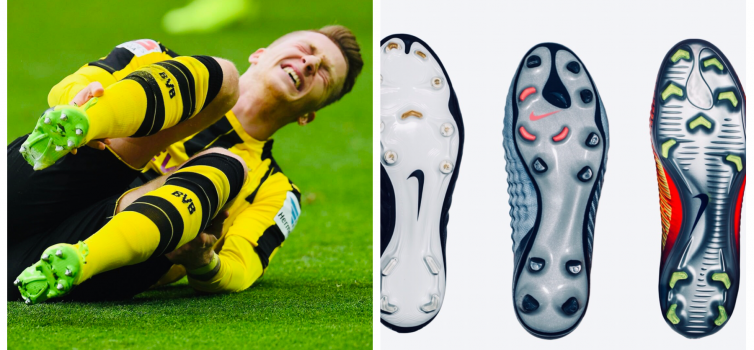Athol Thomson: Why players need more help with footwear choices

Written by Athol Thomson — June 28, 2019
ONE factor that significantly influences injury risk in football is the interaction between a player’s boot and the playing surface.
Foot fixation - or the feeling that studs are trapped on the grass during a rotational movement - is a mechanism that is commonly associated with injury.
This is why, at Aspetar, we have been studying ways to reduce this rotational traction in the run-up to the 2022 World Cup.
In our most recent piece of research on this subject (you can read the open access paper here), different football boots were loaded onto a portable shoe surface traction testing machine to assess how the studs/ cleats released from the surface during a rotational traction test.
Injury risk associated with high rotational traction
Lower knee flexion angle, higher external knee valgus moments, increased knee joint loading and increased distance from the plant foot to the centre of mass during cutting manoeuvres are some of the changes that happen under higher traction conditions at the shoe-surface interface.
These movements, along with increased loading, have been implicated in anterior cruciate ligament injury and other lower extremity injuries. This is corroborated with evidence from prospective studies showing a significant increase in lower limb injury risk associated with high levels of rotational traction.
Importantly, higher rotational traction (as opposed to translational traction) has been found to be a significant predictor of peak ACL force during a maximal change of direction.
The test
Testing was repeated at five individual time points to collect data across one season on the Qatar national team training pitch. Surface mechanical properties (hardness and soil moisture) and climate data (temperature and humidity) were assessed during each test to study their possible relationship with shoe surface traction. You can see the portable shoe surface traction testing machine below.

Six different football shoes, all manufactured by Nike, were tested:
- One artificial grass (AG) outsole (Nike Tiempo legend VII Pro AG)
- Four firm ground (FG) outsoles (Mercurial vapor XI FG, Magista obra II Elite FG, Tiempo legend VII FG, and Hypervenom Phantom III FG)
- One soft ground (SG) outsole (Tiempo legend VII Pro SG).
You can see them below.

According to a worldwide professional football shoe database (footballbootsdb.com), our sample shoes included four of the six most-used football shoes in the world. The shoes were grouped according to their outsole type for further analysis.
- Artificial grass (AG) shoes have several small, short, round moulded studs that are generally used on artificial turf.
- Firm ground (FG) shoes have moulded cleats, blades, or round studs (not screw-in) that are generally used on firm, dry surfaces.
- Soft ground (SG) shoes have fewer, longer, conical metal screw-in studs for wet, muddy, or low surface traction conditions.
Findings
Peak rotational traction measured at the shoe surface interface varied substantially across different months of the year, different grass species and with different shoe outsole types.
Warm season grass tested with the soft ground shoe showed the highest magnitude of rotational traction, while cool season grass tested with an artificial ground shoe showed the least.
Conclusions
At the moment, there is little or no objective data to help players or medical/ sports science teams choose the best footwear on a particular day.
Subjective feedback is all there is - ie you try on a pair of shoes during the warm-up and decide if the traction feels too little/ too much or just right. Providing some objective data on ground hardness or traction can surely help players and medical staffs.
Overall, choosing a shoe with lower rotational traction with no detriment to performance is recommended.

Selecting low levels of rotational traction when players return to field-specific rehab or training after a significant lower extremity injury in which torque is involved as the primary mechanism of injury (such as anterior cruciate ligament tear or syndesmosis ankle injury) would surely be pragmatic.
The current data shows that the variability within a single season is large enough to warrant tailoring of footwear across different months. Shoes with lower rotational traction help minimise the risk of their foot becoming trapped on the surface during turning or cutting movements.
Obviously too little traction can cause slips, so finding the balance for good straight line (translational) traction with reduced rotational traction can be key.
Future reserch
In Doha, we are one year into a study investigating mechanical shoe surface traction testing and lower extremity injury in football. This prospective cohort study examines the injury data from 12 professional male football teams and any relationship to the magnitude of shoe surface traction forces across three seasons.
Future research should investigate other populations (female players, youth and veteran players) and other playing surfaces (artificial v natural v hybrid v reinforced grass etc).
- Athol Thomson is a research scientist and podiatrist at Aspetar in Doha.



-1.png)





